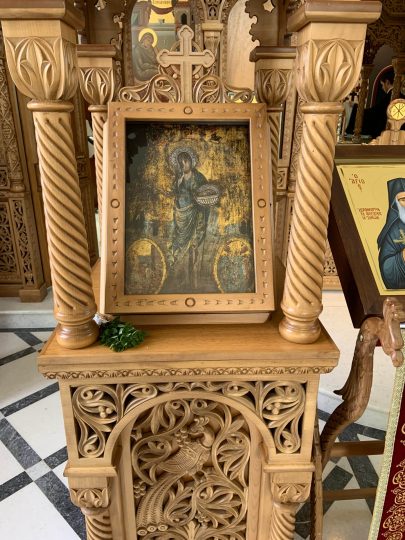Saint John the Baptist
Life

The glorious Prophet and Forerunner John the Baptist is also referred to as John the Forerunner because he was the forerunner of Christ. He was an ascetic and great prophet, who baptized Christ and became one of the most revered saints in the Orthodox Church. John is a cousin of Christ through his mother Elizabeth who was the daughter of Zoia. Zoia is the sister of Christ’s grandmother. Saint John was later beheaded by Herod in the first century to satisfy the request of Herod’s stepdaughter, Salome, and wife Herodias. Because he baptized Christ, he is the patron saint of godparents. He is sometimes called the Angel of the Desert; because of this title, he is sometimes depicted with wings.
Isaiah 40:3-5 is commonly read as a prophecy of John. His father, Zacharias, was a priest of the course of Abia (1 Chr. 24:10), and his mother, Elizabeth, was of the daughters of Aaron (Luke 1:5). John held the priesthood of Aaron, giving him the authority to perform baptisms of God.
His birth took place six months before that of Jesus, and according to the Gospel account he was expected by prophecy (Matt. 3:3; Isa. 40:3; Mal. 3:1) and foretold by an angel. Zacharias lost his power of speech because of his unbelief over the birth of his son, and had it restored on the occasion of John’s circumcision (Luke 1:64). Saint John was a Nazarite from his birth (Luke 1:15; Num. 6:1-12). He spent his early years in the mountainous tract of Judea lying between Jerusalem and the Dead Sea (Matt. 3:1-12). He led a simple life, wearing rope (gamla) fiber clothing and eating “locusts and wild honey” (Matt. 3:4).
As an adult, Saint John started to preach in public, and people from “every quarter” were attracted to his message. The essence of his preaching was the necessity of repentance and turning away from selfish pursuits. He denounced the Sadducees and Pharisees as a “generation of vipers,” and warned them not to assume that their heritage gave them any special privilege (Luke 3:8). He warned tax collectors and soldiers against extortion and plunder. His doctrine and manner of life stirred interest, bringing people from all parts to see him on the banks of the Jordan River. There, he baptized thousands unto repentance.
The fame of Saint John reached the ears of Jesus in Nazareth (Matt. 3:5), who came from Galilee to Jordan to be baptized by him, on the special ground that it became him to “fulfill all righteousness” (Matt. 3:15). John’s special office ceased with the baptism of Jesus, who must now “increase” as the King come to his kingdom. He continued, however, for a while to bear testimony to the Messiahship of Jesus. He pointed him out to his disciples, saying, “Behold the Lamb of God.” His public ministry was suddenly (after about six months probably) brought to a close by his being cast into prison by Herod, whom he had reproved for the sin of having taken to himself the wife of his brother Philip (Luke 3:19). He was shut up in the castle of Machaerus, a fortress on the southern extremity of Peraea, nine miles east of the Dead Sea, and here he was beheaded at the instigation of Herodias; later tradition also implicates Salomé. His disciples, having consigned the headless body to the grave, went and told Jesus all that had occurred (Matt. 14:3-12). Saint John’s death occurred apparently just before the third Passover of Jesus’ ministry.
Jesus himself testified regarding Saint John that he was a “burning and a shining light” (John 5:35). Saint John was the last of the Old Testament prophets, thus serving as a bridge figure between that period of revelation and Jesus Christ. There is a tradition that, following his death, Saint John descended into Hell and there once more preached that Jesus the Messiah was coming.
Jesus said of Saint John, “For I say to you, among those born of women there is not a greater prophet than John the Baptist; but he who is least in the kingdom of God is greater than he” (Luke 7:28).
Feast Days
The Orthodox Church remembers Saint John the Forerunner on six separate feast days, listed here in order of the church year which begins on September 1:
- September 23 – Conception of Saint John the Forerunner
- October 12 – The Russian Orthodox Church observes the Transfer of the Right Hand of the Forerunner from Malta to Gatchina (1799).
- January 7 – The Commemoration of Saint John the Forerunner (main feast day, immediately after Epiphany on January 6)
- February 24 – First and Second Finding of the Head of Saint John the Forerunner
- May 25 – Third Finding of the Head of Saint John the Forerunner
- June 24 – Birth of Saint John the Forerunner (Patronal feast day of the Monastery)
- August 29 – The Beheading of Saint John the Forerunner
Also, Saint John’s parents Zechariah and Elisabeth, are commemorated on September 5.
Hymns
The Nativity of the Honourable Forerunner, Saint John the Baptist
Dismissal Hymn (Fourth Tone)
Prophet and Forerunner of the coming of Christ, although we cannot praise you worthily, we honour you in love at your nativity, for by it you ended your father’s silence and your mother’s barrenness, proclaiming to the world the incarnation of the Son of God!
Kontakion (Third Tone)
Today the formerly barren woman gives birth to Christ’s Forerunner, who is the fulfilment of every prophecy; for in the Jordan, when he laid his hand on the One foretold by the prophets, he was revealed as Prophet, Herald, and Forerunner of God the Word.